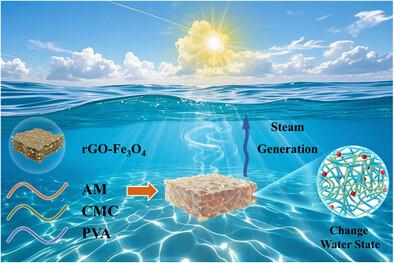Jellyfish-Head Core-Shell Structured Hydrogel Evaporator with Low Enthalpy and Excellent Salt-Resistance for Highly Efficient Solar Desalination
IF 12.1
2区 材料科学
Q1 CHEMISTRY, MULTIDISCIPLINARY
引用次数: 0
Abstract
Solar-driven interfacial water evaporation is a promising technology for seawater desalination and wastewater treatment, offering an effective solution to the global freshwater shortage. However, traditional solar evaporators often suffer from low evaporation rates due to limitations imposed by the theoretical evaporation enthalpy. In recent years, hydrogel-based evaporators have shown great potential in enhancing evaporation performance due to their ability to regulate water states and reduce evaporation enthalpy. In this study, a multi-network PAM/CMC/PVA/rGO-Fe3O4 hydrogel with a jellyfish-inspired core-shell structure is fabricated via a simple free-radical polymerization and physical crosslinking method, where PVA serves as a flexible outer shell and PAM/CMC form the internal scaffold. By tuning the PVA content, the ratio of intermediate water to free water in the hydrogel system is optimized, achieving a high ratio of 1.60, which effectively reduces the evaporation enthalpy. Under 1 kW·m−2 (1 Sun) irradiation, the high evaporation rate of the hydrogel evaporator is as high as 1.90 kg·m−2·h−1. In practical seawater desalination tests, it still maintains an excellent rate of 1.82 kg·m−2·h−1, indicating strong performance retention. Moreover, the material shows no significant salt accumulation under high-salinity conditions and also exhibits excellent performance in wastewater treatment, highlighting its great potential for application in complex water purification scenarios.

海蜇头核壳结构水凝胶蒸发器,具有低焓和优异的耐盐性,用于高效太阳能海水淡化
太阳能驱动的界面水蒸发技术是一种很有前途的海水淡化和废水处理技术,为解决全球淡水短缺提供了有效的解决方案。然而,由于理论蒸发焓的限制,传统的太阳能蒸发器的蒸发速率往往较低。近年来,水凝胶蒸发器由于具有调节水态和降低蒸发焓的能力,在提高蒸发性能方面显示出巨大的潜力。本研究通过简单的自由基聚合和物理交联方法,制备了一种具有水母型核壳结构的多网络PAM/CMC/PVA/rGO-Fe3O4水凝胶,其中PVA作为柔性外壳,PAM/CMC形成内部支架。通过调整PVA含量,优化了水凝胶体系中中间水与游离水的比例,达到了1.60的高比例,有效降低了蒸发焓。在1 kW·m−2 (1 Sun)照射下,水凝胶蒸发器的高蒸发速率高达1.90 kg·m−2·h−1。在实际的海水淡化试验中,仍保持了1.82 kg·m−2·h−1的优异速率,性能保持良好。此外,该材料在高盐度条件下没有明显的盐积累,在废水处理中也表现出优异的性能,在复杂的水净化场景中具有很大的应用潜力。
本文章由计算机程序翻译,如有差异,请以英文原文为准。
求助全文
约1分钟内获得全文
求助全文
来源期刊

Small
工程技术-材料科学:综合
CiteScore
17.70
自引率
3.80%
发文量
1830
审稿时长
2.1 months
期刊介绍:
Small serves as an exceptional platform for both experimental and theoretical studies in fundamental and applied interdisciplinary research at the nano- and microscale. The journal offers a compelling mix of peer-reviewed Research Articles, Reviews, Perspectives, and Comments.
With a remarkable 2022 Journal Impact Factor of 13.3 (Journal Citation Reports from Clarivate Analytics, 2023), Small remains among the top multidisciplinary journals, covering a wide range of topics at the interface of materials science, chemistry, physics, engineering, medicine, and biology.
Small's readership includes biochemists, biologists, biomedical scientists, chemists, engineers, information technologists, materials scientists, physicists, and theoreticians alike.
 求助内容:
求助内容: 应助结果提醒方式:
应助结果提醒方式:


